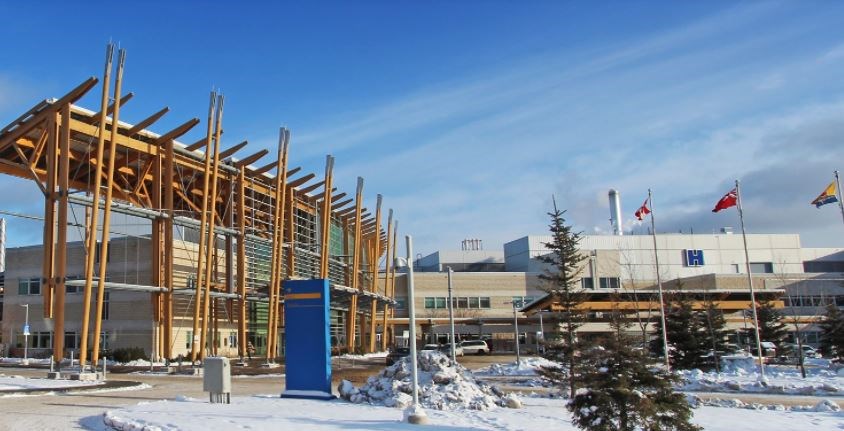THUNDER BAY – Dozens of staff members at Thunder Bay’s regional hospital are off work due to COVID-19, but CEO Rhonda Crocker Ellacott says that hasn’t yet posed a threat to the hospital’s ability to provide care.
However, the recent surge of COVID-19 cases in the community, and a growing number of infected patients in hospital, has forced the Thunder Bay Regional Health Sciences Centre to postpone non-urgent surgeries, among numerous other measures.
There were 14 COVID-positive patients in hospital on Thursday, down one from the day before. The number of COVID patients in the Intensive Care Unit held steady at two.
The TBRHSC has moved from code orange to code red, reopening a dedicated COVID unit, pausing non-urgent surgeries, and limiting the number of volunteers and care partners allowed in hospital.
The COVID care unit in the 3B wing is currently operating with 12 available beds, but can expand if necessary, Crocker Ellacott said.
The hospital had closed its COVID unit in July of 2021.
Patients are now allowed only one essential care partner, with some exceptions for palliative and end-of-life patients.
The hospital has adopted what’s known as directive two following guidance from Ontario’s Ministry of Health. The measure ramps down non-urgent procedures to ensure capacity is available to respond to rising COVID-19 cases.
That will mean a potential backlog for those awaiting so-called elective surgeries, who will be contacted. Crocker Ellacott said the hospital will do its utmost to minimize the impact, including by ramping up surgeries as quickly as possible once the directive is lifted.
“The real risk and fine line is ensuring that those patients who really need emergency and urgent care continue to receive that care,” said Crocker Ellacott. “We work together with our clinicians very closely to ensure… that no patient [is without] care when they need it.”
There were 66 hospital staff off work self-isolating as of Wednesday, due to either testing positive for COVID-19 or having a possible exposure.
Those cases and exposures are not related to a COVID-19 outbreak declared in the 3A unit, Crocker Ellacott said.
The CEO, who was appointed in late 2020, said the number of staff off work due to COVID-19 was a concern.
However, she said the situation wasn’t yet serious enough for the hospital to consider reducing staff isolation periods, or even allowing COVID-positive staff to continue working, a step recently taken in Quebec after an explosion of cases caused severe staff shortages.
“We haven’t considered returning COVID-positive staff to work,” Crocker Ellacott said. “I won’t say it wouldn’t be something down the road, depending on what the nature of the situation would be. We have our infection prevention and control experts who guide us through this process, and certainly anything like that would be taken incredibly seriously.”
“At this point in time, we’re following the restrictions that’s in place from the Ministry of Health. We’re using the isolation guidance that’s recommended – in fact, we’ve gone a little bit further just to ensure the safety of both our staff and our patients, and their families.”
The hospital has not shared the number of people infected as part of the 3A outbreak. Provincial guidelines define a hospital outbreak as two or more confirmed cases within a specified unit within 14 days, where both could have reasonably acquired their infection in hospital.
Crocker Ellacott said because of the “very small” number of patients involved in the outbreak, giving a specific number would be a breach of personal health information.
It has proven difficult to determine exactly how the outbreak began, she added.
“The number [of people infected as part of the outbreak] is still incredibly small,” she said. “Given what we’re seeing with Omicron, it’s very challenging at times to determine where a patient or a staff could have come across Omicron, given the transmissibility of it.”
The outbreak is “contained,” with the unit closed to new admissions and new precautions in place, she said.
Crocker Ellacott said she’s “optimistic” the local experience will follow early indications elsewhere that Omicron sends more people to hospital, but with less severe symptoms and shorter stays.
“It’s really too early to tell for us – we’re probably a couple of weeks behind what the Greater Toronto Area is experiencing. At this point, [we expect we] would see more patients that require more short-term supportive care outside the ICU… but again, sometimes the story changes.”
As of Wednesday, the hospital had a 92 per cent occupancy rate, while the ICU was 77 per cent occupied.
Despite the COVID challenges, the hospital remains ready to provide care for those who need it, Crocker Ellacott emphasized.
“Our emergency department is safe,” she said. “We have the appropriate skilled teams ready to care for patients who require it, so the community doesn’t need to be concerned whether its hospital is safe or ready.”
Still, the hospital has warned those with less severe illnesses could face longer waits, and has encouraged those with mild COVID symptoms to call their primary care provider or TeleHealth Ontario for advice on managing symptoms at home.
